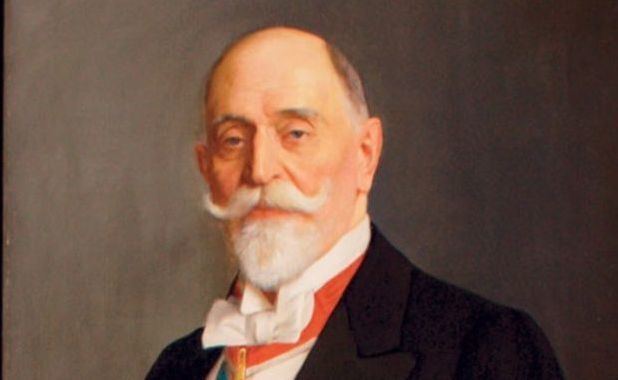Preceded by Filip Hristic Preceded by Tihomilj J. Markovic Nationality Serbian | Succeeded by Tihomilj J. Markovic Succeeded by Ljubomir Sreckovic Name Dorde Vajfert | |
 | ||
Died 12 January 1937Belgrade, Kingdom of Yugoslavia | ||
Gudfelaz or e vajfert
Đorđe Vajfert (Serbian Cyrillic: Ђорђе Вајферт, German: Georg Weifert; 15 June 1850, Pančevo – 12 January 1937, Belgrade) was a Serbian industrialist of German descent, Governor of the National Bank of Serbia and later Yugoslavia. In addition, he is considered the founder of the modern mining sector in Serbia and a great benefactor.
Contents
Kvadratura kruga or e vajfert
Biography

Georg Weifert was born in Pančevo, German Banat to a Danube Swabian family. From an early age Đorđe Vajfert worked with his father, Ignatz Weifert in Belgrade, in brewing. Theirs was the first brewery in the Kingdom of Serbia. He graduated from the Braumeisterschule in Weihenstephan, near Munich. Then he returned to Serbia and took over the brewery of his father, which he expanded. With the profits he bought a coal mine in Kostolac, then a copper mine in Bor, a Steinberg works at Zaječar and finally a gold mine. With the proceeds from the mines, he was the richest man in Serbia and was considered the greatest industrialist of the future Yugoslavia.
In 1890 Vajfert was appointed Governor of the National Bank of Serbia. He served in this capacity from 1890 to 1902, and again from 1912 to 1914/1918. During this period he acquired a good reputation maintaining the value of the Serbian dinar and in credit. After 1918, because of his good offices, Vajfert was appointed Governor of the National Bank of Yugoslavia. His best-known arrangement as Governor was the conversion of the Austro-Hungarian krone into the new Yugoslav dinar. This also led to great criticism, as the former Serbian dinar was exchanged 1:1 in the new dinar, the Austrian money into a 4:1 ratio - this led to substantial losses of property of those Yugoslavs who formerly lived in Austria-Hungary.
Đorđe Vajfert was an important patron and supporter of humanitarian and cultural institutions. He donated his prized collection of ancient coins and his private library to the University of Belgrade. In Pančevo, from where his parents Ignatz and Anna originated, he left the Roman Catholic Church a small chapel known as Anina crkva (the Church of Anna), in memory of his mother.
As a major benefactor, opened a large Catholic cemetery Pancevo, where they are still the remains of family members Vajfert. They also built a fund from your Pancevo St. Anne Catholic Church and many other public and charitable institutions.
He died on 12 January 1937, at 17:20 pm at his villa in Belgrade. The funeral service was held in the Catholic Church of St. Anne Pancevo 14 January, and the 15th was buried in the Catholic cemetery Pančevo. The heir to his business empire was his nephew Ferdinand Gramberg. Since 2001, his portrait is depicted on the 1000 Serbian dinar note.
